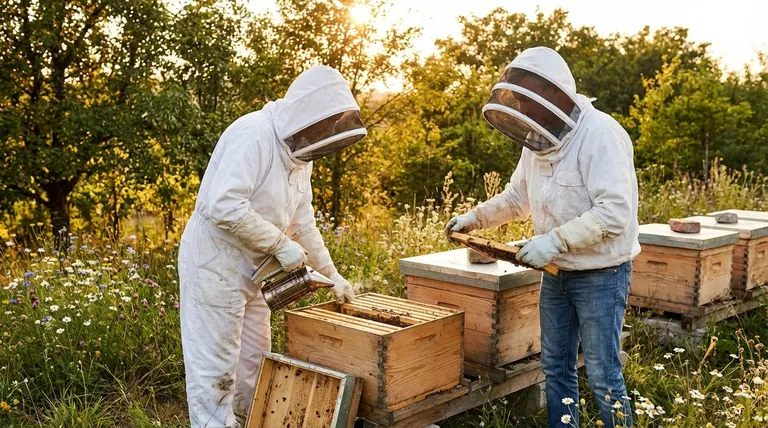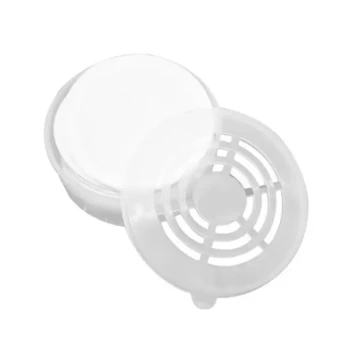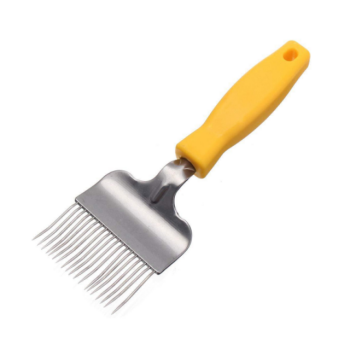In short, a beekeeping suit is a full-body, one-piece garment providing coverage from your ankles to your wrists, while a beekeeping jacket only covers your upper torso. The suit offers comprehensive protection, making it the standard for beginners, whereas the jacket provides convenience for experienced keepers performing quick tasks.
The decision between a suit and a jacket is not about which is universally "better," but about making a calculated trade-off between maximum protection and practical convenience, based on your experience level and the temperament of your bees.

The Core Difference: Coverage
The primary distinction between these two essential pieces of protective gear lies in how much of your body they cover. Understanding this is the first step in choosing the right tool for your beekeeping journey.
The Full Beekeeping Suit: Maximum Security
A full beekeeping suit is a one-piece, zip-up garment that covers you from your ankles to your neck and wrists. It is designed to be a self-contained barrier against stings.
Most suits feature elastic at the wrists and ankles to create a tight seal, preventing bees from crawling inside. They almost always include an integrated or detachable veil to protect your head, face, and neck.
The Beekeeping Jacket: Targeted Protection
A beekeeping jacket is essentially the top half of a full suit. It's a long-sleeved garment, also made of sting-resistant material, that protects your arms and torso.
Like a suit, a jacket includes a veil for head and face protection. However, it offers no coverage for your legs, requiring you to pair it with thick, durable pants like heavy jeans or overalls to ensure adequate lower-body protection.
Key Factors in Your Decision
Choosing between a suit and a jacket goes beyond simple coverage. It involves balancing your need for security with the practical realities of working with your hives.
Protection Level and Peace of Mind
For a beginner, the confidence that comes from full-body protection cannot be overstated. A full suit eliminates worries about bees crawling up pant legs or finding a gap between a jacket and pants.
This comprehensive coverage is also critical in regions with more defensive bees, such as Africanized Honey Bees, where maximum protection is non-negotiable.
Convenience and Comfort
This is where the jacket shines. Many experienced beekeepers prefer a jacket because it is far easier and faster to put on and take off, much like a standard hoodie.
For quick tasks like refilling a feeder or a brief hive inspection, the convenience of a jacket often outweighs the need for full-body armor. It is less cumbersome and allows for better overall movement.
The Role of Experience
As you gain experience, you learn to read your colony's mood and work calmly to minimize defensive behavior. This is why many veteran beekeepers feel comfortable using a jacket for most situations.
Many experienced keepers own both, choosing the full suit for intensive work like honey harvesting or dealing with an agitated colony, and grabbing the jacket for routine checks.
Understanding the Trade-offs
Every piece of equipment has its pros and cons. Being aware of them is crucial for making an informed choice that aligns with your goals and comfort level.
The Suit: Security at a Cost
A full suit offers unparalleled protection, which is its greatest strength. It provides the peace of mind needed to learn the craft without the constant fear of stings.
The downside is that it can be hotter, more restrictive, and more of a chore to get into and out of compared to a jacket.
The Jacket: Flexibility with a Caveat
A jacket provides excellent convenience and is often more comfortable in warm weather. Its ease of use makes beekeeping feel less like a major operation.
The significant caveat is the exposed lower body. You are responsible for ensuring your pants are thick enough to prevent stings and that there is no gap where the jacket ends and your pants begin.
Making the Right Choice for Your Apiary
Ultimately, the right gear is the one that keeps you safe and comfortable. Use your specific situation as your guide.
- If your primary focus is learning as a new beekeeper: A full beekeeping suit is the recommended choice to build confidence with maximum protection.
- If your primary focus is convenience for quick hive inspections: A beekeeping jacket, paired with durable pants, offers an ideal balance of protection and ease of use.
- If your primary focus is safety while working with defensive bees: A full beekeeping suit is essential and should be considered mandatory.
Choosing the proper protective gear allows you to focus on the health of your bees and the joy of the craft.
Summary Table:
| Feature | Beekeeping Suit | Beekeeping Jacket |
|---|---|---|
| Coverage | Full-body (ankles to wrists) | Upper torso and arms only |
| Best For | Beginners, defensive bees, intensive work | Experienced keepers, quick inspections |
| Protection Level | Maximum security | Requires pairing with durable pants |
| Convenience | More restrictive, hotter | Easier and faster to put on/take off |
Ready to Gear Up with Confidence?
Whether you're a new beekeeper needing the comprehensive security of a full suit or an experienced apiary manager looking for the convenience of a jacket for quick checks, having the right protective gear is fundamental to your success and safety.
HONESTBEE supplies top-quality beekeeping suits, jackets, and other essential equipment to commercial apiaries and beekeeping equipment distributors. We understand the critical balance between protection and practicality. Our wholesale-focused operations ensure you get durable, reliable gear that protects you and lets you focus on what matters most: the health of your bees.
Let's discuss your apiary's needs. Contact our team today to find the perfect protective solutions for your operation.
Visual Guide

Related Products
- Cotton Folding Square Beekeeping Hat and Veil with Removable Mesh Bee-Proof Design
- Wholesales Dadant Size Wooden Bee Hives for Beekeeping
- Professional Insulated Plastic Bee Hives
- Long Langstroth Style Horizontal Top Bar Hive for Wholesale
- Automatic Honey Flow Beehive 4 Frame Mini Hive for Beekeeping
People Also Ask
- How can I keep ants out of my honey? A Simple, Permanent Solution
- What are the key features of a beekeeping hat and veil? Choose the Right Protection for Your Apiary
- What is the function of a beekeeper hat and veil? Essential Head & Face Protection for Beekeepers
- What are the different types of beekeeping veils? Choose the Right Protection for Your Apiary
- What factors should be considered when purchasing a beekeeping suit or jacket? Your Guide to Safety and Comfort



















